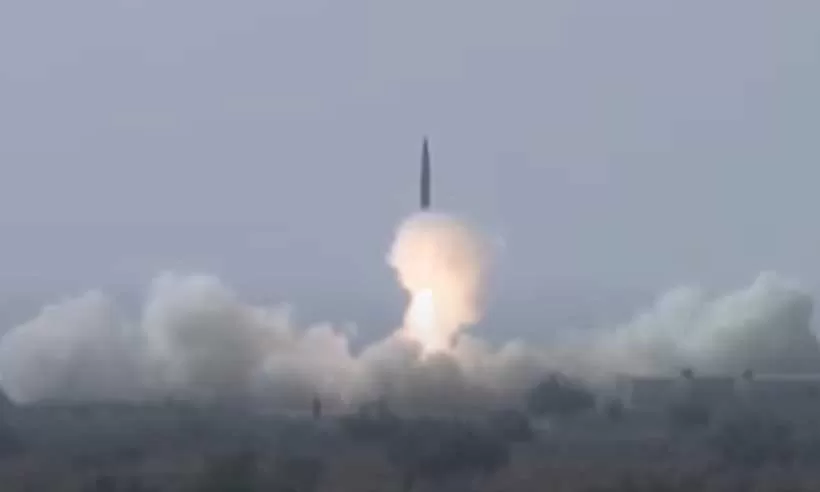Pakistan announced successful test-firing of Shaheen-II surface-to-surface ballistic missile, which was a major boost to country’s defense power. This is not merely a military exercise that the Pakistan army participates in on an annual basis, for the Pakistan government, it represents a commitment to upgrade its defense capabilities in a region that has become, significantly, more unpredictable. Shaheen-II, an upgraded missile system still remains a testimony to Pakistani intent that it will continue to uphold strong deterrent power that will secure the country along with helping in the distribution of power balance in the region.
It is the Shaheen series which form the backbone of Pakistan’s ballistic missile system that has developed over the years to strengthen its strategic capability. The Shaheen-I which was initiated in the early 2000s was the starting point of this process, providing a short-range ballistic missile ranging from 750 km. The idea is that the Shaheen-II, which can cover distances of up to 1,500 kilometers, which is far more advanced. This missile can be armed with conventional and nuclear warheads making it a strategic asset of Pakistan defense infrastructure. This range makes the Shaheen-II capable of delivering ordinance on large parts of the Indian subcontinent and the Indo-pacific region, including large population density areas and strategic targets. With a solid-fuel rocket propulsion system, it has the advantage of speed and can be used in different operations within the combat theatre. As a result of a rather high accuracy of missile launches and high power of the equipped payload, the missile becomes an effective means of preventing any potentially aggressive actions towards Pakistan.
The successful launch of the Shaheen-II is an evidence that the security of Pakistan has gone to the next level. It captures a period of research, development and investment in minimum credible defensive machinery which is essential in protecting the nation’s border’s. In a place where force defines relations, a powerful nuclear missile system guarantees no external forces would invade Pakistan’s soil and that it would in fact be able to neutralize any threats.
The Shaheen-II especially improves the Pakistan’s second-strike capability – one of the theoretical premises of nuclear deterrence. This capability means that when Pakistan is attacked with nuclear first strike it stands ready and capable of replying with equal force, that alone is likely to deter any adversary from thinking of such a plan. Thus, by successfully test-firing this missile, Pakistan not only proves this technological capacity but also a strategic intent.
The launch of Shaheen-II has important consequences for the region and especially for South Asia, given that this part of the world is still marked by bitter conflict legacies and highly fluid and contested security structures. India closely monitors any advancements made in Pakistan’s missile program, and the Indian’s missile program is regarded by its neighbors with equal mistrust.
The recent test of the Shaheen-II can be expected to generate a number of responses. In India’s case, it is as an annual exercise where it is forced to remember that there is a security threat out there in the region. However, India also have advanced missiles of its own inventory such as the Agni series of missiles and the Shaheen-II’s range and capability reflect the fact that there are fully fledged arms race going on between these two nuclear powered neighbors. This tendency, on the one hand helps to stabilize the situation in a ‘balance of terror,’ while on the other, makes one question the nature of escalation in the context of a crisis.
For other regional actors such as china and the gulf states the Pakistani missile prowess is yet another demonstration of the security dynamics of south Asia. In terms of power politics, Shaheen-II provides an enhanced status of strategic independence to Pakistan to meet the challenges of the region. It also firmly establishes Pakistan in the larger docket of the Islamic countries where there is respect and admiration of the country’s military might.
The effective launch of the Shaheen-II is indicative of more than just a technical achievement; it is an assertion of power by Pakistan’s military. In a world where perception determines reality, being capable of building and launching immensely effective missiles cannot be a mere addendum of power. The relationship between Pakistan and missile capability of its military is inherently intertwined and it can be said with a considerable measure of certainty that has been an unalterable component of Pakistan’s state power system. Pakistan and missile capability of its military have close links between them and it can be boldly stated that it has been an indispensable part of the Pakistan’s state power.
The Shaheen-II, with its added increased range and accuracy capability than its predecessor, is not only brings added strategic boost to the defense sector of Pakistan, but at the same time is a mark of its technical advancement. This test shows that the country is capable of adjusting to new demands in security threats. Moreover, it sends a strong message to the international community: Pakistan is a willing and able player on the international level, willing to assert its sovereign rights and drawn to maintain peace in the region.
Shaheen-II missile serve as the milestone in the advancement of posture of Pakistan in defense technology and in region as well. As the country strives to survive this ever-present challenge of the global neighborhood in South Asia it can form a potent deterrent instrument in the arms inventory so that Pakistan can guarantee for its independence and can also promote stability in the South Asian region through producing Shaheen-II. This test demonstrates why a credible threat continues to be relevant in a part of the world that has remained a volatile potential theatre of conflict. This missile test proves that credible threats still prevail in a part of the world that has remains a potential war zone. While Pakistan develops its ability in defending itself and its interests, Shaheen-II remains as a crucial weapon in its arsenal.
